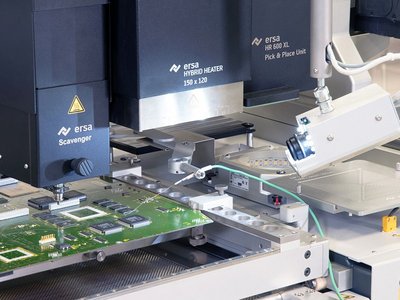

02/2024 | Best Practice Rework
In the rapidly changing world of electronics manufacturing, repair, touch-up, or rework of electronic assemblies, which includes the replacement of defective components on printed circuit boards (PCBs), has become an important and common practice. The following article will take a closer look at the removal of residual solder – i.e., the professional preparation of the assembly before installing a new component. Preventing damage to the PCB is paramount, and extracting solder without surface contact is key to enhancing process reliability in the repair of BGAs and similar components.
While a component is being desoldered from a circuit board, the solder in a joint melts unevenly. Depending on the temperature and condition of the component lead, some of it remains on the component, and a variable proportion of the solder sticks to the pad of the circuit board. A specific amount of solder must be defined for the new component to be installed so that the repaired assembly corresponds to the serial products in terms of function and reliability. Particularly with fine-pitch components and bottom terminated components (BTCs), the correct amount of solder must always be applied when replacing components. Both poorly wetted solder joints and those carrying too much solder bear the risk of subsequent failures.
So far, the remaining solder has often been removed manually to obtain uniformly pre-tinned solder connections as a starting point. This is a time-consuming process which, depending on the qualifications of the person carrying out the work, is not always free of errors. Quite often, scratches in the solder resist will occur, or even torn off solder pads. Today, automated, non-contact solder removal is favored in most cases.


The main productive advantages of non-contact extraction of residual solder are, firstly, that the assembly´s surfaces are not scratched, i.e. there is no mechanical stress. Secondly, the solder extraction process can be carried out very quickly, continuously, and automatically. As a result, the thermal load is also moderate and the cleaning result is very uniform.
With the most common systems, either the working height of the extraction nozzle above the PCB can be fixed or a distance control system ensures that a defined working height is maintained. Depending on the component whose residual solder needs to be removed, a suitable extraction nozzle is selected, and the desired track movement is predefined for automatic systems: for example, linear tracks for QFPs or a meandering track for ball grid arrays (BGA). For larger BGAs, a rectangular nozzle can be used, which cleans a wider strip at the same speed than the standard nozzle, thus accelerating the process. For a component with a side length of 44 mm, the processing time is cut from approximately six minutes to about half.
The Ersa scavenging units are fully integrated modules and can also be retrofitted to the respective rework systems. They work with a hot gas heating that is independent of the rework system. Preheated nitrogen is used to remelt the solder locally. To ensure the gentlest possible heating, the bottom heater of the rework system keeps the assembly at an adjustable preheating temperature. Finally, the integrated vacuum nozzle extracts solder residues and flux from the solder joints and discharges them into a collection container and process gas filter.
Prior to component re-soldering: Before a new component can be placed and soldered, the solder volume removed during cleaning is refilled. This is not only important for uniform solder joint formation: The new solder deposit also contributes to homogeneous heat transfer. The added flux removes the oxide layers created during desoldering and cleaning. The new component can be printed with solder paste or dipped in solder or flux paste (in the case of BGAs). Solder paste can also be applied with a dispenser or printed onto the assembly using a stencil. However, the latter methods can take a long time and be inconvenient due to limited space. In addition, solder paste can melt if the assembly is still warm. Ersa´s Dip&Print Station allows the components to be prepared easily and efficiently so that a new installation is always successful.
Ersa already offers additional modules for non-contact residual solder extraction for its rework systems. These can also be retrofitted to existing machines. The SC 550 SCAVENGER is suitable for the HR 550 and HR 550 XL rework stations. The SC 600 AUTO SCAVENGER is available for the HR 600 XL and further systems to come.